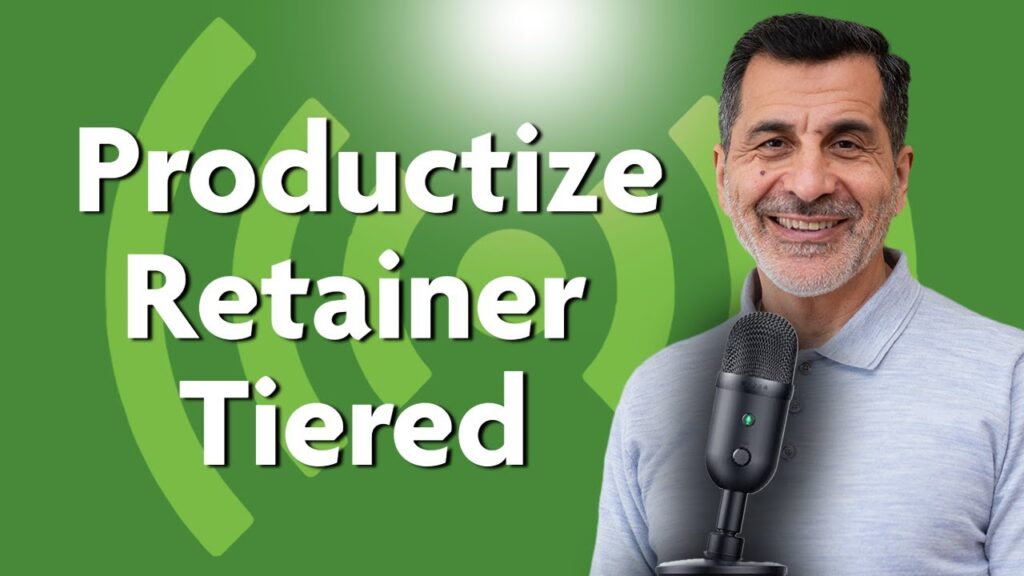Navigating Pricing Models: Finding the Right Consulting Pricing for Your Business

“Nowadays people know the price of everything and the value of nothing.”
– Oscar Wilde
The question on every new founder’s mind is, “How do I determine the right pricing strategy for my consulting business?”
The answer depends on the type of services offered, your level of experience, and the market. The path that arrives at the “right” price isn’t always clear – there is no single price that fits all situations. In this article, we will look at key pricing strategies and provide a guide you can use to determine the best strategy (and price) for you.
Watch the live stream where I cover this topic in depth:
Understanding Your Value Proposition
Stop selling your services; start selling value.
Every business transaction is an exchange of value – more exactly, perceived value.
No matter what pricing setup you pick, it’s likely too low if it doesn’t reflect the value you offer. Competing solely on price in the long run leads to a downward spiral – it’s not sustainable.
A consulting business needs to understand and communicate its unique value proposition (UVP). Your UVP showcases the benefits of your services, setting you apart from rivals and showing clients why they should choose you.
Identifying the Unique Value You Bring to the Marketplace
Begin by asking what makes you exceptional. This is not the time to be shy.
- What is it that makes you a rockstar?
- What do you do differently compared to others?
- When you look at your market or industry, what do all other consultants get wrong or misunderstand that you have figured out?
Consider how all of these work together to give your clients unique advantages.
Communicating Your Value Proposition
Once you know what makes you stand out, explain it well to the demographic you’re targeting. Create a story that shows how your services meet client needs and provide real, impactful benefits.
Use language that resonates with your audience and emphasizes the value they will gain from partnering with you. Here are a few examples:
- Strategic Advisory: “We leverage decades of industry experience and a data-driven approach to help clients navigate complex challenges and achieve predictable and sustainable growth.”
- Digital Transformation: “We empower businesses to embrace innovation, streamline operations, and capitalize on emerging AI technologies so they can lead the pack.”
- Change Management: “With a proven track record of successful change management initiatives, we guide organizations through major transitions with a human-centric approach, making sure your team excels while feeling safe.”
- Communications Coach: “I empower your communication skills with coaching tailored to your goals, whether it’s mastering public speaking or enhancing your leadership presence and authority.”
When you know and talk about what makes you unique, your consulting services become essential. When clients see your value, it’s easier to charge a fair price.
In the world of consulting, prices can vary widely. Some offer great value at low prices, while others charge a lot without delivering much. So, how do you stay competitive? By making sure what you offer is worth every penny to your clients. If you consistently deliver top-notch results, you’ll always stand out, no matter what others are charging.
Free vs. Paid Work
While working for free should be avoided, sometimes it may be beneficial, such as gaining traction, securing larger contracts, or giving back to the community. However, always consider the value exchange and avoid exploitation.
Common Consulting Pricing Models
As a service consultant, you’ve got different ways to set your prices. Knowing them helps you pick what works best for your consulting business. Don’t fret about too many choices. I’ll share with you a simple guide to choose the right pricing model for whatever business stage you’re at.
Below you will find the most common strategies along with the pros and cons of each.
Hourly Pricing
Hourly pricing is pretty straightforward. You decide on a rate per hour for your services and bill clients according to the hours you work. If you’ve had a job where you weren’t paid a fixed salary, you know how this works.
Pros:
- Straightforward and easy to calculate.
- Provides flexibility for both the consultant and the client.
Cons:
- May lead to uncertainty for clients regarding total costs.
- Encourages time-based billing rather than value delivered.
- Risk of undervaluing the rate by not factoring in overhead.
- Requires detailed time tracking and disciplined focus.
When to Use: Use hourly pricing for quick projects or when the work scope is uncertain with many unknowns. It’s also great for long-term projects with changing month-to-month needs.
Project-Based Pricing
Project-based pricing is common. You make a detailed proposal up front with the project’s scope, what’s delivered, and what success means. Include all your time and costs, like specialized services or subcontracting.
Example: An IT consultant setting a fixed price for a project that includes assessing, designing, and then training a team to use a new system with post-implementation check-ins over the course of six months.
Pros:
- Offers clarity and predictability for both parties.
- Aligns incentives between the consultant and the client to complete the project efficiently.
Cons:
- Requires accurate estimation of project scope and potential changes.
- Risk of scope creep leading to additional charges.
- Early founders may not have enough data to estimate enough time/resource allocation.
When to Use: Suitable for well-defined projects with clearly defined deliverables along with clearly defined roles and responsibilities for both the client and the service provider.
Value-Based Pricing
Value-based pricing is about charging based on the value your services bring to the client, not just the time or effort. In this model, a consultant looks at how their services benefit the client’s business, like boosting revenue or saving costs, and sets prices accordingly.
But value-based pricing can also be related to the perceived value added because of your service. For example:
There’s an old parable about a steamship breaking down at a port town on the Mississippi River. The engine wouldn’t light. The operator was looking to lose a lot of revenue if he couldn’t keep his passengers happy and gambling.
The operator scoured the port town and quickly found the only steamship mechanic for miles. The mechanic arrived an hour later and promptly went to work diagnosing the issue. He tried the controls, looked at the boiler, and followed the pipes until he reached one junction. He stopped, pulled out a ball peen hammer, and tapped. The engine roared back to life, and all gauges showed full power.
“You’re a lifesaver,” the operator said. “How much do I owe you?”
“$500,” he said.
The operator was flabbergasted. $500 was a lot of money. “I won’t pay unless you give me an itemized invoice.”
The mechanic pulled out a notebook and began writing. He then gave the slip to the operator:
- Tapping with the hammer …… $1.00
- Knowing where to tap ………$499.00
When you match the price with the value, you can earn a part of the revenues or savings your client gets and also strengthen your client relationships by gaining trust.
It shows that you understand your client’s needs, goals, and desired results, so you can customize your offer and price to fit them.
Example: An online sales consultant charging a base plus a percentage of the increase in online sales revenue.
Pros:
- Reflects the impact and value of the consultant’s expertise.
- Can lead to higher margins and stronger client relationships.
Cons:
- Requires a deep understanding of the client’s business and the value proposition of the services.
- In some situations, accurately quantifying value is difficult.
When to Use: Recommended for high-value projects where the consultant can show a significant impact on the client’s bottom line.
Performance-Based Pricing:
You may hear the term performance-based pricing, which is a subset of value-based pricing. It’s when your compensation is tied directly to the benefits gained by the client.
An example would be a marketer who runs paid ad campaigns and doesn’t charge any service fees but is highly compensated when they achieve the result of X new leads on top of other lead sources.
If you choose this model, make sure you have control of all aspects of the performance metrics.
Tiered Pricing
Tiered pricing is a model where consulting services are offered at different levels, each with its own set of features and corresponding price points.
Picture a software consulting firm offering tiered pricing for its development services. They might have three tiers: basic, standard, and premium.
In the basic tier, clients get essential services like code review and bug fixes at a lower price.
The standard tier might add things like ongoing support and maintenance.
The premium tier could offer priority support and custom feature development.
With tiered pricing, clients pick the tier that suits their needs and budget, making it a flexible choice for different requirements.
Example: Offering different levels of service, or tiers, at varying price points such as bronze, silver, gold, and platinum.
Pros:
- Provides options for clients with different needs and budgets.
- Can increase perceived value through tier differentiation.
Cons:
- Requires careful segmentation and positioning of service tiers.
- Risk of clients opting for lower-priced tiers without understanding the full value of higher tiers and feeling underserved.
When to Use: Suitable for consulting businesses with a range of service offerings catering to a wide variety of client needs.
Retainer Pricing
Retainer pricing is where your clients pay a fixed fee on a recurring basis to retain your services. It’s like having a subscription for ongoing access to expertise and support.
Consider a marketing consultant who provides a retainer package. Clients pay a monthly fee for a specified number of hours or services like social media management, content creation, or advertising campaigns. This model brings predictability, offering a steady income for the consultant and fixed costs and services for the client.
Examples: Charging a fixed monthly or annual fee for ongoing graphic design services for all branding, website updates, and marketing material needs.
Pros:
- Ensures a steady stream of income and fosters long-term relationships with clients.
- Offers predictability for both parties.
Cons:
- Requires a high level of trust between the consultant and the client.
- Risk of underutilization, which may lead the client to question the overall value that you provide.
- Risk of overutilization, which may create more delivery burden than you anticipated.
When to Use: Appropriate for providing ongoing support, advisory services, or maintenance contracts.
No single pricing model fits all situations, and sometimes, providers blend different approaches. To find the ideal pricing structure for your business, you might need to try various models. Assessing common pricing strategies and how they fit your consulting business helps you make informed choices that match your objectives and meet client needs.
But first, consider all the factors influencing your strategy.
Factors Influencing Consulting Fees
When setting your consulting fees, factor in:
- expertise
- industry demand
- client budgets
Expertise matters: clients value specialized skills and experience and are often willing to pay more for top-tier consultants.
Industry demand influences pricing too: higher demand often means higher fees, following basic economic principles.
Think about your pricing model carefully – hourly, project-based, value-based, tiered, or retainer – and adjust based on demand and competition.
Last, remember your clients’ budgets: while you aim for fair pricing, ensure it aligns with their financial capacity and the value you deliver. Offering top-notch solutions at unaffordable rates is a no-win situation.
Don’t create animosity by price gouging.
Even without competition, avoid making clients feel trapped without options; prioritize their satisfaction over premium pricing. Charging high rates isn’t always good for your business; consider the long-term implications for client relationships.
Balancing these factors ensures that your pricing remains competitive while also aligning with your revenue goals.
Tips for Assessing Pricing Benchmarks
To set your prices well, research the market thoroughly.
- Check competitors’ pricing. Find consultants or firms like yours and check their prices. Many businesses hide their fees and pricing strategies from public view, so you may need to get creative in doing this research.
- Approach your network. Approach your network looking for connections to those who recently worked with a competitor, or who received multiple proposals for a project. Ask if you can look at the proposals.
- Follow up when you lose a deal. If you lose a deal to a competitor, ask your prospect what the price and terms were or if you could get a glance at the winning proposal. It never hurts to ask, though sometimes non-disclosure provisions get in the way.
- Join a professional association. They often share survey results on pricing trends. Networking with other professionals can also help gather more data on fees.
These forms of research give context for your pricing strategy and help you position your services effectively in the market.
Implementing Competitive Pricing Strategies for Profitability
Pricing isn’t one-size-fits-all. You’ll need to consider different tactics to find the balance between competitiveness and profit.
If you want to make a profit, ensure that you account for every expense and resource you use to accomplish your work. Don’t just focus on the time spent.
Except for hourly rates, it’s best to focus on the value delivered rather than the time invested. Here are some items to think about when calculating a competitive price:
- Equipment and supplies needed to conduct your business
- Expenses related to your office space: leasing, fees, utilities, telecommunications, etc.
- Non-billable time spent in sales and marketing: sales calls, networking, composing presentations and proposals, emails, content creation, and research
- Software fees for CRM, web/domain hosting, marketing funnel platforms, scheduling, video meetings, or specialized project platforms
- Professional association fees, networking events, conference attendance and travel, and promotional items
- Service fees involved in your work, such as access to databases or data libraries
- Third party services such as subcontractors, market research firms, virtual assistants, market research firms, etc.
Here’s a quick example:
Hourly Price = (Total Annual Costs + Desired Profit) / Billable Hours per Year
For example: Let’s say your total annual costs are $100,000 while your desired profit is $50,000 and you plan to work 1,500 billable hours per year.
Hourly Price = ($100,000 + $50,000) / 1,500 Hourly Price = $150,000 / 1,500 Hourly Price = $100 per hour
Ideally, you will want to meet at a price point that is both highly profitable AND competitive.
How to Stand Out in the Market
To stand out in the market, consider implementing different strategies so that competing on price alone isn’t a driving force. As mentioned earlier, competing on price is a race to the bottom. What if you could stand out by offering pricing in a way no one else does?
Instead of the industry standard, say a monthly retainer, you might offer project pricing for one-time jobs. This type of service, known as productized services, involves offering a specific, repeatable service as a standalone project that clients can buy like a product.
There are many alternatives to competing in this manner including offering unique service bundles, creating tiered pricing structures, or providing value-added services that your competitors don’t offer.
Let’s revisit your UVP – the thing that separates you from the rest. By highlighting what sets you apart, you can justify premium pricing while remaining competitive.
Service Business Pricing Model Examples
Let’s delve into some hypothetical examples of pricing models for different service businesses:
- Management Consulting Firm:
- Hourly Rates: Invoicing clients based on the number of hours – billable time – worked on their projects.
- Project-Based Pricing: Quoting a fixed fee for delivering a strategy assessment or a competitive analysis.
- Value-Based Pricing: Aligning fees with the perceived value of the solutions provided to clients.
- Digital Marketing Agency:
- Tiered Pricing: Offering different service packages like branding or SEO assessment at varying price points based on the scope of services and level of support.
- Retainer Pricing: Charging clients a monthly fee for 4 weekly newsletters.
- Performance-Based Pricing: Structuring fees based on the achievement of predefined paid-search goals or metrics.
- Legal Consultancy:
- Flat-Fee Billing: Charging a fixed price for standard legal services such as sales contract reviews or employment offer letter drafting.
- Subscription-Based Pricing: Offering clients access to legal advice and support for a monthly or annual subscription fee, possibly at an incentivized rate.
- Hybrid Pricing: Combining different pricing models to tailor pricing to the specific needs of each client.
By studying these examples and customizing them to your consultancy’s services and target audience, you can create competitive pricing strategies for growth.
Think beyond the norm.
Would a subscription-based project rate be effective? How about offering tiered services based on value? Or perhaps a new combination that showcases your strengths and competitive edge?
A Case Study for Pricing Strategy (Pardon my French)
Recently, I connected with a business owner struggling to make ends meet while remaining competitive in his field. Like many founders, this gentleman, who I’ll call Ted, wanted more clients.
Ted lives in France and helps his students learn English. For his services, he was charging roughly $20 US an hour. I asked him if it would be better to raise his prices instead of taking on more clients, and he rebuffed me. “If I raise my prices, I’ll lose all my clients,” he insisted.
So we explored what he did specifically and who his competitors were. One competitor was charging less per hour, which increased Ted’s anxiety.
In our talk, I discovered Ted was more than just a language teacher. He was well-qualified, helping students prepare for the TOEFL exam, required for non-native English speakers to attend US colleges. Ted focused on teaching English for advanced academic studies, giving his students a strong edge in pursuing higher education in the US.
Focusing on his expertise and credentials, we crafted an offer that focused on his UVP: advanced English for elite students to pass the TOEFL, GRE and GMAT exams.
With my urging and despite his reluctance, Ted doubled his prices.
For new clients, he implemented the new rates. He informed existing clients of the price increase, but offered a discounted rate for three months. With his valuable services, clients readily agreed, finding the price worthwhile. Ted doubled his revenue without upping his marketing efforts or workload.
From here, he could (if he chose to) offer tiered pricing with different goals for each package. He could even include cultural training and partner with businesses in the US to help his clients adapt to their new community and make valuable connections.
In short, by focusing on his UVP, Ted could increase his revenue and open opportunities for even more growth by looking at ways to expand on the value he offered his students.
Create the Ultimate Pricing Strategy for Your Consulting Business
Let me give it to you straight: you will make pricing mistakes. You will win deals you underpriced and will work for near minimum wage to complete the project. You will forget to include key costs, and you will lose deals because you misunderstood the scope and priced too high.
It’s okay.
Failure is learning. You’re learning how to price your services. It can be a scary and bumpy road. But now you have the permission and a bit of guidance to enter this realm better prepared. Take the bold step, make the steep ask, offer the unusual package. You may be surprised how many times the lead will say, “Yes, let’s do this.”
A Simple Consulting Pricing Guide
While we covered a lot in this article, don’t succumb to paralysis by analysis – stuck in research mode and never trying a different pricing strategy until you find the “perfect” one. The only way to learn the best pricing is through trial and error.
That said, here’s what I hope will be a helpful guide and serve as a pricing guide – a framework – you can follow to help avoid some common pitfalls. Like an infant, you need to crawl before you walk and walk before you run.
Crawl Phase
- Number of successfully completed projects: 0-5
- Developmental phase as a business: Knowledge Accumulation Phase. You don’t know what you don’t know. You may have a good sense of what to do for a project, but you lack actual beginning-to-end experience to understand every variable. For each project, use a time tracker such as Timeneye or Toggl, even if you are not billing hourly, so you have a real sense of what a project takes. Plan to make mistakes and earn very little.
- Pricing: Hourly. Project Based (with research). Free for small one-off projects to half what you want to charge in the near future.
Walk Phase
- Number of successfully completed projects: 5-10
- Developmental phase as a business: Normalization Phase. You’re learning from your mistakes and beginning to see what it takes to successfully complete a project. You’ve most likely lost a few deals, which can also provide insight into pricing approaches that leads aren’t responding to favorably. On the projects you’ve won, you’re continuing to track time as in the Crawl phase. You can now get a feel for what’s involved to better price your projects and offer a retainer solution. Charge full price.
- Pricing: Hourly, Project-Based, Retainer.
Run Phase
- Number of successfully completed projects: 11+
- Developmental phase as a business: Acceleration Phase. You have a solid understanding of what it will take to deliver what the client wants to +/- 10%. You begin to see patterns in needs and what you offer in your UVP, which you will probably refine and tighten. Along the way, you have most likely become more efficient and productive, reducing the number of hours needed while charging the same price. Consider increasing prices 25 – 100%.
- Pricing: All pricing strategies.
A Recap of Finding the Right Strategy for Your Business
- Value Proposition: Focus on communicating the unique value your services offer rather than just selling services. Understanding and articulating your value proposition is essential for setting competitive prices.
- Identify Unique Value: Reflect on what makes you exceptional in your field and how you differentiate yourself from competitors. Consider factors like expertise, method, and client relationships.
- Communicate Value: Once you’ve identified your unique value, craft a compelling narrative to communicate it effectively to your target audience. Highlight specific ways your services address client needs and deliver tangible results.
- Common Pricing Models: Explore various pricing models such as hourly rates, project-based pricing, value-based pricing, tiered pricing, and retainer pricing. Understand the pros, cons, and when to use each model.
- Factors Influencing Fees: Consider factors like expertise, industry demand, client budget, and competition when determining consulting fees. Balance profitability with competitiveness to set prices that align with your goals and client expectations.
- Assess Pricing Benchmarks: Conduct thorough market research to understand industry standards and competitive rates. Network with peers, join professional associations, and analyze competitor pricing to inform your pricing strategy.
- Implement Competitive Strategies: Tailor fee strategies to your business needs, considering factors like expenses, client expectations, and value differentiation. Experiment with pricing models to find the right balance between profitability and competitiveness.
- Avoid Underpricing: Many founders underprice their services because of lack of context or fear of losing clients. It’s crucial to understand the value you provide and price accordingly, balancing competitiveness with fair compensation.
- Avoiding Overpricing: While increasing prices is often advisable, avoid overestimating your value and pricing yourself out of the market. Conduct competitive research and consider factors like experience and credentials when setting prices.




